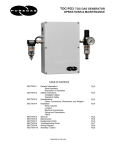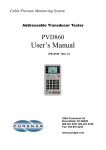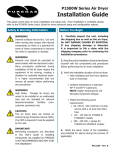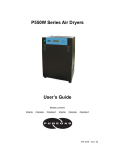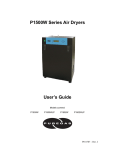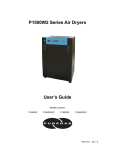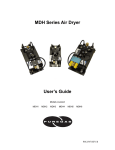Download Puregas TOC Instruction manual
Transcript
Instruction Manual for PUREGAS Compressed Air Dryers and Adsorbers Models: PHF PCR PCDA PHCA PCME PMD TOC PUREGAS LLC 226A Commerce Street Broomfield, CO 80020 Tel: 800-521-5351 Fax: 303-657-2205 [email protected] www.puregas.com Made in USA P010535 Rev. E 09/11 Instruction Manual for PUREGAS Compressed Air Dryers and Adsorbers IMPORTANT NOTE! This instruction manual is designed for the benefit of our customers and is intended to assist them with the installation, operation, and maintenance of their PUREGAS compressed air dryer or adsorber. The entire manual should be read thoroughly prior to the installation of the unit and should be retained for future reference. Failure to do so could result in safety issues and poor performance, and could void the warranty. LIMITED WARRANTY AGREEMENT All PUREGAS products carry a one-year warranty against defective workmanship and material. This period starts with the date of shipment. PUREGAS retains the right to address warranty claims by shipping replacement parts or by having the unit returned to our factory for repair. No claims for labor in replacing defective parts or for consequential damages will be allowed. Replacement parts will be invoiced in the regular way, with invoices subject to adjustment after the parts claimed defective are examined at our factory. No units or parts will be accepted at our factory for warranty repairs or credit without previous authorization from PUREGAS. Damage incurred to the product in transit will be the responsibility of the customer, who in turn should file a damage claim against the responsible carrier. This warranty shall not apply to any product which has been repaired or altered in any way by anyone other than PUREGAS, so as to affect its proper function. Neither will this warranty apply to a product subjected to misuse, negligence, or accidental damage. CAUTION! Pressure: Do not exceed maximum operating pressure as listed on the serial label and be sure that the system is depressurized before servicing. Electrical: Install this product in compliance with national and local electrical codes. Breathing Air: This product is not intended for breathing air applications, and air treated by this equipment may not be suitable for breathing without further purification. Instruction Manual for PUREGAS Compressed Air Dryers and Adsorbers Table of Contents SECTION 1 – GENERAL...........................................................................................................................................1 SCOPE OF MANUAL ....................................................................................................................................................1 INITIAL INSPECTION ...................................................................................................................................................1 WARRANTY ................................................................................................................................................................1 SECTION 2 – DESCRIPTION OF OPERATION ...................................................................................................1 GENERAL DESCRIPTION..............................................................................................................................................1 APPLICATIONS ............................................................................................................................................................1 OPERATION OF PHF, PCDA, PHCA AND PCME MODELS .........................................................................................2 OPERATION OF PCR MODEL ......................................................................................................................................3 OPERATION OF PMD AND TOC MODELS ...................................................................................................................4 SECTION 3 – INSTALLATION AND OPERATION .............................................................................................5 INSPECTION ................................................................................................................................................................5 LOCATION ..................................................................................................................................................................5 MOUNTING .................................................................................................................................................................5 RECOMMENDED INSTALLATION DIAGRAM .................................................................................................................8 PIPING AND AIR CONNECTIONS ..................................................................................................................................8 INLET AND OUTLET FILTRATION ................................................................................................................................9 PRESSURE AND FLOW CONTROL.................................................................................................................................9 INSTRUMENTATION ..................................................................................................................................................10 ELECTRICAL CONNECTIONS AND TIMER...................................................................................................................10 OPERATING PRESSURE AND SIZING ..........................................................................................................................11 OTHER OPERATING ISSUES .......................................................................................................................................12 SECTION 4 - MAINTENANCE ..............................................................................................................................13 GENERAL INFORMATION ..........................................................................................................................................13 ANNUAL INSPECTION ...............................................................................................................................................13 MAINTENANCE SCHEDULE .......................................................................................................................................14 SECTION 5 – REPLACEMENT PARTS ...............................................................................................................15 GENERAL INFORMATION ..........................................................................................................................................15 SECTION 6 – TROUBLESHOOTING INFORMATION.....................................................................................21 GENERAL INFORMATION ..........................................................................................................................................21 TROUBLESHOOTING MATRIX....................................................................................................................................21 Figures FIGURE 1: OPERATION OF PHF, PCDA, PHCA AND PCME MODELS ......................................................................2 FIGURE 2: OPERATION OF PCR MODEL ......................................................................................................................3 FIGURE 3: OPERATION OF PMD AND TOC MODELS ..................................................................................................4 FIGURE 4: DIMENSIONS OF PHF, PCDA, PHCA, AND PCME MODELS .................................................................5 FIGURE 5: DIMENSIONS OF PCR MODEL ....................................................................................................................6 FIGURE 6: DIMENSIONS OF PMD AND TOC MODELS .................................................................................................7 FIGURE 7: RECOMMENDED INSTALLATION DIAGRAM ................................................................................................8 FIGURE 8: WIRING DIAGRAMS ...................................................................................................................................11 FIGURE 9: EXPLODED VIEW OF PHF, PCDA, PHCA AND PCME MODELS ............................................................15 FIGURE 10: REPLACEMENT PARTS FOR PHF, PCDA, PHCA AND PCME MODELS............................................16 FIGURE 11: EXPLODED VIEW OF PCR MODEL........................................................................................................17 FIGURE 12: REPLACEMENT PARTS FOR PCR MODEL ..............................................................................................18 FIGURE 13: EXPLODED VIEW OF PMD AND TOC MODELS .....................................................................................19 FIGURE 14: REPLACEMENT PARTS FOR PMD AND TOC MODELS ..........................................................................20 SECTION 1 – GENERAL Scope of Manual This instruction manual is intended to assist our customers with the installation, operation, and maintenance of their PUREGAS compressed air dryer or adsorber. The information contained in this manual is designed to ensure a productive, trouble-free ownership experience and should be retained for future reference. Initial Inspection PUREGAS products are produced in a lean manufacturing environment, where quality assurance practices are built into all processes. Moreover, all products are thoroughly inspected and tested prior to shipment. If shipping damage is noted, immediately contact the responsible carrier to file a freight claim to cover the repair. Warranty Please read this instruction manual carefully prior to installing and operating your PUREGAS product. Failure to follow these instructions could lead to potential safety concerns and may void the warranty. The warranty agreement can be found on the inside cover of this instruction manual. SECTION 2 – DESCRIPTION OF OPERATION General Description PUREGAS compressed air dryers and adsorber are used to separate various elements in compressed air using Pressure Swing Adsorption (PSA) technology. This method employs two identical desiccant chambers, precision orifices, and solenoid valves controlled by a solid state electronic timer. The process is simple. The compressed air is directed through a desiccant chamber, which contains an adsorbent material with strong affinity for moisture, CO2, and/or other elements within the air stream. Once purified, the majority of the compressed air goes directly to the application, while a portion is diverted through an orifice to regenerate the off-line chamber. The solid state timer reverses the flow through the chambers on a timed cycle by opening and closing the solenoid valves. Applications As described above, PUREGAS compressed air dryers and adsorbers are typically used to purify a compressed air source. They may, however, be used with inert gases (nitrogen, argon, neon, helium, and carbon dioxide), as well as other common gases with certain restrictions. For example, oxygen requires a completely oil-free system and hydrogen (being explosive) should be handled with explosion-proof equipment. Page 1 of 24 Please consult the factory PRIOR to installing a unit for any application other than air or inert gases. Use with certain liquids or gases could be harmful to the unit, result in a combustible condition, or cause hazardous leakage. In the event of a misapplication, the product warranty is voided and PUREGAS will assume no responsibility or liability for any resulting loss. Operation of PHF, PCDA, PHCA and PCME Models The PHF, PCDA, PHCA and PCME models utilize a common die-cast aluminum manifold, to which the desiccant towers (chambers), 3-way solenoid valves, timer, and other components are attached. The inlet air passes upward through the desiccant tower immediately above the energized DC solenoid valve. When the air reaches the top of the tower, it is redirected back down the return air tube in the center of the tower, through the open check valve, and into the outlet passageway. Most of the air is delivered to the application, while a portion is diverted for purging the off-line desiccant tower. This air passes through the fixed orifice beneath the off-line tower, upward through the air tube, and then downward through the desiccant, removing the accumulated moisture and/or other contaminants. These unwanted elements of the gas stream exit the unit through the purge port of the de-energized solenoid. This process is reversed every 30 seconds to provide a continuous source of pure, ultra-dry air. Desiccant Air Tube Tower 2 Check Valve (Closed) Orifice Dry gas Outlet Tower 1 Check Valve (Open) Wet Gas Inlet To Atmosphere 3-way Solenoid Valve FIGURE 1: OPERATION OF PHF, PCDA, PHCA AND PCME MODELS Page 2 of 24 Operation of PCR Model As previously described, the PCR model employs PSA technology to effectively remove moisture (or other unwanted components) from a compressed air stream. It is, however, configured differently than other PUREGAS models based on a common air manifold. Instead of a manifold and 3-way valves to direct the airflow through the unit, the PCR model uses shuttle valves and 2-way solenoid valves. The inlet (lower) shuttle valve directs the compressed air flow into one of the two desiccant chambers where nearly all of the water vapor is removed. The shuttle valve contains an internal disk, which “shuttles” back and forth in the valve body based on the pressure differential created by the 2-way valves (one of which is open and the other closed). The ultra-dry air leaving the desiccant chamber passes through the outlet shuttle valve to the application. A precision orifice in the outlet shuttle disk, however, allows a portion of the dry outlet flow to be redirected back through the off-line tower to purge it of the accumulated moisture. The purge stream exits the unit through the open solenoid valve directly below the chamber. The solid state timer controls the process by opening and closing the solenoid valves every 60 seconds, which switches the inlet flow to the regenerated tower. FIGURE 2: OPERATION OF PCR MODEL Page 3 of 24 Operation of PMD and TOC Models The PMD and TOC models also employ Pressure Swing Adsorption (PSA) technology to remove water vapor and/or CO2 from ordinary compressed air. These models are configured differently than the PHF or PCR models, in that they employ a shuttle valve and 4-way valve to direct the airflow through the unit. The 4-way valve directs the incoming air into one of the two desiccant chambers, where the water vapor and/or CO2 are removed. Most of the purified air leaving the desiccant chamber passes through the outlet shuttle valve to the application. A precision orifice in the outlet shuttle disk, however, allows a portion of the purified air to be redirected back through the off-line tower, purging it of the accumulated moisture and CO2. The purge air exits the unit through the 4-way valve and muffler. A solid state timer governs the process by controlling the 4way valve. FIGURE 3: OPERATION OF PMD AND TOC MODELS Page 4 of 24 SECTION 3 – INSTALLATION AND OPERATION Inspection Remove the compressed air dryer or adsorber from the shipping carton. Inspect the unit for any visible shipping damage. If shipping damage is noted, immediately contact the responsible carrier to file a freight claim to be reimbursed for the repair. Location Desiccant-type compressed air dryers and adsorbers should be installed in the coolest practical location that is not subject to freezing temperatures. An acceptable temperature range is between 40oF (4oC) and 125oF (52oC). Although the unit will operate at higher temperatures, the operating life of the components will decrease at temperatures much above 85oF (29oC). Bear in mind that abrasive dust and chemicals will also reduce the life of any electromechanical device. Mounting All of the models covered by this instruction manual can be wall-mounted using the brackets provided. Products should be mounted with the desiccant towers in a vertical orientation for best results. Be careful to not overtighten purge mufflers. NOTE: Dimension “A” can be 6, 9, 12, or 20, depending on model. Dimensions in inches. FIGURE 4: DIMENSIONS OF PHF, PCDA, PHCA, AND PCME MODELS Page 5 of 24 MODEL A B C D E F PCR 15 18.625 6 25.5 3.25 5.5 8.25 PCR 25 22.935 6 30 4.25 6.4 9.25 PCR 50 28.125 6 35.25 4.25 6.4 9.25 Note: All dimensions are in inches. FIGURE 5: DIMENSIONS OF PCR MODEL Page 6 of 24 TOC MODEL PMD-S PMD-M TOC Height (A) 10 12 10 12 Width (B) 4 5 4 15 Depth (C) 4 5 4 5 with cabinet & filters Note: All dimensions are in inches FIGURE 6: DIMENSIONS OF PMD AND TOC MODELS Page 7 of 24 Recommended Installation Diagram A diagram of the recommended installation is below. It depicts all of the essential elements of a properly installed compressed air dryer or adsorber, as well as certain options described in the following sections. FIGURE 7: RECOMMENDED INSTALLATION DIAGRAM Piping and Air Connections IMPORTANT! Do not apply air pressure to the PCR, PMD, or TOC models unless the unit is also being supplied with electrical power. Without power, the unit will not cycle and the online tower will soon become saturated. There are four ways of connecting the PHF, PCDA, PHCA and PCME models. These models are set-up at the factory such that the airflow through the unit is from left-to-right (as you face the front of the unit). If an alternative arrangement is desired (airflow from right-to-left or in/out on the same side), the port plugs on either side of the unit can be rearranged accordingly. Please note that the arrows on the top surface of the manifold indicate the inlet and outlet ports on both sides. The inlet for the PCR model is in the main body of the lower shuttle valve, while the outlet is in the upper shuttle valve. Please note that the orientation of both the inlet and Page 8 of 24 outlet can be changed if necessary. This is accomplished by detaching the shuttle valve from the tower and reassembling it with the desired orientation. The inlet for the PMD model (and the TOC model without a cabinet) is the brass fitting fastened to the bottom of the 4-way valve, and the outlet is the brass fitting in shuttle valve at the top of the unit. The word “OUT” is inscribed in the shuttle valve body. The inlet of the standard TOC model, is the filter on the left side of the cabinet (as you face the front of the unit). The outlet is on the right side of the filter-regulator body. All ports on the PHF, PCDA, PHCA and PCME models are ¼” female NPT, while the PCR model ports are ½” female NPT. The ports on the PMD and TOC models are typically 1/8” female NPT, although ¼” NPT is optional with the cabinet. Use Teflon tape or pipe sealant on all threaded connections. Prior to putting the unit into service, it is advisable to check air connections for leakage by applying a diluted soap solution. If tubing is used, be sure it has low moisture permeation and a sufficient pressure rating. A bypass line is optional. It should be installed, however, if the application requires constant airflow while the dryer or adsorber is being serviced. Moreover, adding an inline scrubber to this bypass line will protect the downstream application while the dryer or adsorber is being serviced. Electrically controlled shut-off valves and check valves should also be employed as needed to prevent air from entering the de-energized unit. Inlet and Outlet Filtration Appropriate inlet filtration is mandatory for all models. Particles of dirt, rust or scale, as well as condensed moisture and oil, are readily adsorbed by the desiccant, but cannot be purged during the regeneration cycle. Thus, these solid and liquid contaminants will significantly deteriorate the product’s performance and shorten it useful life. For most compressed air sources, both a 5-micron particulate filter and a 0.01-micron coalescing filter are recommended to optimize performance and extend maintenance intervals. If the compressed air source is of instrument grade quality, the coalescing filter by itself will usually offer sufficient protection. In both cases, the filters should have automatic drains to avoid the frequent maintenance required by manually drained filters. Outlet filtration is recommended for many applications. A 5-micron filter, installed at the outlet of the dryer or adsorber, will effectively remove any desiccant dust that may migrate from the desiccant chambers over time. PUREGAS offers an outlet filter, with an integrated pressure regulator and gauge, for all models. Pressure and Flow Control Some means of regulating pressure and flow is required for nearly every application. This should always be done AFTER the dryer or adsorber. Pressure and flow regulation is especially important for applications near atmospheric pressure. As previously stated, PUREGAS offers an outlet filter-regulator for all models, as well as a flow meter with a built-in flow control valve. For those applications especially sensitive to pressure Page 9 of 24 or flow variation, PUREGAS manufactures various tanks, which will completely eliminate downstream pressure surges. IMPORTANT! For optimum performance, the maximum available operating pressure should be maintained across the unit -- up to 150 psig for most models (the maximum operating pressure for the PMD and TOC models is 125 psig). Any pressure reduction or flow control should be done downstream of the unit. Instrumentation The primary purposes of instrumentation in the system are process control and troubleshooting. The instruments shown in the Recommended Installation Diagram are therefore in most cases optional, but their initial cost will be quickly justified through improved process stability and problem analysis. A simple, inexpensive means of measuring the moisture content of the outlet air stream can be accomplished with a vial of color-changing crystals. PUREGAS offers such an accessory, which can be mounted directly to the dryer or adsorber. The crystals will change from a dark blue (dry) to pink (wet) depending on the moisture content in the air stream. For sensitive or remote applications, PUREGAS manufactures an electronic humidity alarm, which continuously tracks moisture levels and helps prevent costly repairs caused by moisture damage. It features simultaneous audible and visual alarms, as well as open- and closed-circuit conditions for integration into a control system. Electrical Connections and Timer Before wiring, check the product label for electrical characteristics. Although standard electrical characteristics are 115 Volts, 50/60 Hz or 230 Volts, 50/60 Hz, most products are also available in 12 VDC and 24 VDC. There is no electrical overload protection in the product and it should be wired into a protected circuit. While standard on some units, an 8-foot, 3-wire grounded power cord is available as an optional accessory for all products. The unit can be grounded by attaching a wire to a timer assembly bracket screw. Please see the Wiring Diagrams that follow. As previously described, the solid state timer controls the switching of the solenoid valves, which in turn direct the air through the unit. All timers are designed with a onehour memory; If power is interrupted, the dryer will resume operation at the same point in the cycle when the power is restored. The standard timer for the PHF and PHCA models simultaneously switches the solenoid valves every 30 seconds (for a total cycle time of 1 minute). The timer used on the PHFR, PCDA and PCME models maintains the same cycle, but allows a repressurizing period of 3.75 seconds prior to switching chambers. Re-pressurizing helps Page 10 of 24 minimize the outlet pressure and flow variation, as well as desiccant shock as the flow switches from one chamber to the other. The PCR model also utilizes a re-pressurizing timer. It maintains a 2-minute cycle, with a 7-second re-pressurizing period prior to switching towers. The PMD and TOC models follow a standard 1-minute cycle like the PHF300A model. The timer wiring diagrams for all models are shown in Figure 8. PCR Model PHF, PCDA, PHCA & PCME Models PMD and TOC Models FIGURE 8: WIRING DIAGRAMS Operating Pressure and Sizing Most PUREGAS models are designed to operate at pressures up to a maximum of 150 psig. The only exceptions are the PMD and TOC models, which have a maximum operating pressure of 125 psig. It is important to note that all models based on PSA technology will achieve better performance at higher operating pressures. Therefore, any pressure regulation should be done downstream of the dryer or adsorber. Page 11 of 24 The sizing of the purge orifice is also important to the performance of a PSA system. The orifice must be large enough to admit sufficient air to purge the off-line tower, but not too large to be wasteful of the dry or purified air. Please note that the operating pressure is closely associated with the orifice sizing, since both the orifice aperture dimension and pressure determine the quantity of purge air. The purge orifice size of a particular unit is indicated by the last 2-3 digits of the model number (found on the product label). The orifice number for the PHF, PCDA, PHCA and PCME models is also stamped on the top of the purge orifice itself. For the PCR, PMD, and TOC models, the orifice size is stamped on the outlet shuttle valve body. The outlet flow should be regulated with a throttle valve and measured with a flow meter to ensure the capacity of the dryer or adsorber is not being exceeded. PUREGAS offers flow meters with built-in flow control valves for this purpose. IMPORTANT! Each compressed air dryer and adsorber is sized for specific operating conditions. If additional flow is required or the operating pressure decreases, the output performance will be negatively affected unless the orifice diameter is changed appropriately. Depending on the magnitude of the change, the size of the desiccant chambers may also need to be increased. Please consult the product sizing charts or contact the factory for more information. Other Operating Issues At the beginning of each purge cycle, there will be an audible exhaust through the solenoid valve. This sound can be made quieter by the use of purge mufflers (standard on most models) or a sound suppression kit for virtually noiseless operation. Please contact PUREGAS for more information on this option. The exhaust stream may also be piped to a remote location. If this is done, it is important that the exhaust piping is oversized to prevent back-pressure on the purge stream; restricting the purge flow will prevent full regeneration of the desiccant chamber and lead to reduced performance. The heat of adsorption and the operation of the solenoid valves will cause the unit to become warm to the touch. This is normal. To prevent potential electrical shock, the timer cover should not be removed for maintenance until power is disconnected from the unit. Likewise, the unit should be completely depressurized prior to service. Page 12 of 24 SECTION 4 - MAINTENANCE General Information When properly installed and operated, PUREGAS compressed air dryers and adsorbers are designed to deliver years of reliable service without minimal attention. Most recommended maintenance procedures can be easily and quickly performed in the field without the need for specialized tools or skills. Annual Inspection Although optional, an annual inspection of the dryer or adsorber is recommended for critical processes to anticipate potential failures. This inspection should include the following checks: Cycle Timer: Listen for proper desiccant tower cycling. See the Electrical Connections and Timer section of this manual for information on the timing cycle of your model. IMPORTANT! Shut-off the air supply and depressurize the system before attempting the following maintenance checks. Desiccant Towers: Remove the desiccant towers and visually inspect their inlets for excessive dirt or oil fouling, which would indicate possible contamination of the desiccant chambers. If contaminated, replace the desiccant chambers or return them to PUREGAS (or an authorized distributor) for repacking. Please note that repacking the towers is not available for all products. No attempt should be made to repack the chambers in the field, since improper packing can cause channeling of the air stream and lead to reduced performance. NOTE! Removal and inspection of the desiccant chambers should NOT be necessary for at least 3-5 years, if the system includes properly functioning and maintained inlet particulate and coalescing filters with automatic drains. Solenoid Valves: For the PHF, PCDA, PHCA and PCME models only, inspect the sealing surface on the solenoid valve plunger. This requires unscrewing the solenoid valves from the bottom of the manifold. A deteriorated surface will lead to air leakage and reduced performance. If necessary, replace the plunger and base of the solenoid valve assembly by requesting a solenoid valve kit from PUREGAS (or an authorized distributor). Page 13 of 24 Purge Mufflers: Remove the mufflers from the solenoid valves and check for excessive pressure drop by blowing through the muffler. The muffler should be replaced if significant back-pressure is sensed. Filtration: Inlet and outlet filters must be kept clean for efficient filtering. A visible coating of dirt on the element’s surface or an excessive pressure drop (greater than 5-6 psig), indicate that replacement is needed. See the Replacement Parts section in this manual for information on replacement elements for all current filters. For older filters, please see the Product Support section of the PUREGAS website (www.puregas.com) for more information. Maintenance Schedule The following preventive maintenance schedule is recommended to ensure the optimum performance of the unit and to prevent the inconvenience of a sudden, unexpected failure. Please reference the exploded view drawings in the Replacement Parts section to identify specific part numbers for your model. Replace Filter Elements: Replace the inlet and outlet filter elements every 6-12 months depending on the quality of the compressed air source. PUREGAS stocks replacement elements for all of the filters offered with its products. Solenoid Valves on PHF, PCDA, PHCA and PCME Models: Replace the plunger and base of the solenoid valves every two (2) years. PUREGAS offers a Solenoid Repair Kit (P200498S) for this procedure. Two (2) kits are required for each dryer or adsorber being serviced. Replace or Repack Desiccant Towers: Replace or repack the desiccant towers every five (5) years. Please see the following exploded view drawings to determine the tower part number required. Please note that the repack option is only available for the PHF, PCDA, PHCA and PCME models. Replacement towers are available for all other models. Check Valve and O-rings on PHF, PCDA, PHCA and PCME Models: Replace the check ball, check spring, and o-rings for PHF, PCDA, PHCA and PCME models every 6 years. PUREGAS offers a Maintenance Kit (P200499S) for this procedure. One (1) kit is required per dryer or adsorber. This kit contains two Solenoid Repair Kits, two check balls, two check springs, and an assortment of o-rings. Page 14 of 24 SECTION 5 – REPLACEMENT PARTS General Information The following exploded view drawings and tables show the available replacement parts, accessories, and repair kits for all of the compressed air dryers and adsorbers covered by this instruction manual. Please note that parts for non-current models are not listed, but may be available. Simply identify the required parts for your model from the exploded view drawings and contact PUREGAS (or an authorized distributor) to order. PUREGAS Parts can be contacted toll-free at 800-521-5351 or via email at [email protected]. FIGURE 9: EXPLODED VIEW OF PHF, PCDA, PHCA AND PCME MODELS Page 15 of 24 REPLACEMENT PARTS MODEL Desiccant Tower PHF PHF PHF PHF PHF PHF PHF PHF PCDA PCDA PCDA PCDA PHCA PHCA PCME PCME Solid State Timer PHF & PHCA PHF & PHCA PHFR, PCDA & PCME PHFR, PCDA & PCME Solenoid Valve All models All models Solenoid Repair Kit Dryer Maintenance Kit Purge Orifice Mounting Bracket Manifold Cover Manifold All All All All All All models models models models models models SIZE PART NUMBER 6", Black 6", White 9", Black 9", White 12", Black 12", White 20", Black 20", White 12", Black 12", White 20", Black 20", White 12", Black 20", Black 12", Black 20", Black P200403-6 P07323-G27 P200403-9 P07323-G28 P200403-12 P07323-G29 P200403-20 P07323-G30 P07323-G21 P07323-G46 P07323-G22 P07323-G47 P07323-G9 P07323-G12 P07323-G8 P07323-G23 110 VAC 220 VAC 110 VAC 220 VAC P010530-F1 P010530-F2 P010980F1 P010980F2 110 VAC 220 VAC P400589-DC1 P400589-DC2 n/a n/a Specify ## n/a n/a n/a P200498S P200499S P200404-## P010437 P3005052 P300495P ACCESSORIES FOR PHF, PCDA, PHCA, and PCME MODELS Inlet 5-micron Particulate Filter Inlet Carbon Filter Inlet 0.01-micron Coalescing Filter Outlet 5-micron Filter-Regulator Purge Muffler Moisture Indicator Flow meter with Throttle Control Valve Surge Tank, 6.5-liter Sound Suppression Kit 1/4" NPT 5-micron Replacement Element for P010553 1/4" NPT Carbon Replacement Element for P010976F2 1/4" NPT 0.01-micron Replacement Element for P010555 1/4" NPT 5-micron Replacement Element for P010685 1/4" NPT n/a 0.5 - 5 scfm P011047F11 1 - 10 scfm P011047F12 6" diameter x 14" length P010553 P010554 P010976F2 P010657 P010555 P010556 P010685 P010621 P400399 P200405 P08353 P08286 P07994 P08084 FIGURE 10: REPLACEMENT PARTS FOR PHF, PCDA, PHCA AND PCME MODELS Page 16 of 24 FIGURE 11: EXPLODED VIEW OF PCR MODEL Page 17 of 24 REPLACEMENT PARTS MODEL SIZE PART NUMBER Desiccant Tower PCR-15B PCR-15W PCR-SBX PCR-SWX PCR-25B PCR-25W PCR-MBX PCR-MWX PCR-50B PCR-50W 15", Black 15", White 15", Black, CO2 15", White, CO2 19", Black 19", White 19", Black, CO2 19", White, CO2 25", Black 25", White P010764-F1B P010764-F1W P010764-F2B P010764-F2W P010764-F3B P010764-F3W P010764-F4B P010764-F4W P010764-F5B P010764-F5W Solid State Timer PCR-xxx-xA PCR-xxx-xB PCR-xxx-xC PCR-xxx-xD 110 VAC 220 VAC 24 VAC 12-24 VDC P09740 P09783 P010762 P010670 Solenoid Valve PCR-xxx-1A PCR-xxx-2B PCR-xxx-3D PCR-xxx-4D PCR-xxx-5C 110 VAC 220 VAC 12 VDC 24 VDC 24 VAC P010679F1 P010679F2 P010679F3 P010679F4 P010679F5 n/a Specify Orifice ### Specify Orifice ### Specify Orifice ### n/a P010652 P010652, ### P010509, ### P09881F### P09881F000 All models n/a P010734F2 PCRG n/a P010733 Shuttle Valve Inlet (all models) Outlet with gauge option Outlet without gauge option Outlet shuttle disk Inlet shuttle disk Purge Muffler Tower Pressure Gauge ACCESSORIES FOR PCR MODELS Inlet 5-micron Particulate Filter 1/2" NPT 5-micron Replacement Element for P010547 Inlet Carbon Filter 1/2" NPT Carbon P010547 P010554 P010976F3 Replacement Element for P010976F3 P010657 Inlet 0.01-micron Coalescing Filter 1/2" NPT 0.01-micron Replacement Element for P010549 P010549 P010556 Outlet 5-micron Particulate Filter 1/2" NPT 5-micron Replacement Element for P010683 P010683 P010554 Moisture Indicator Kit 1/2" NPT P010103 Flow meter with Throttle Control Valve 2 - 20 cfm 3 - 30 cfm 4 - 50 cfm 1/2" NPT 1/2" NPT 1/2" or 1" NPT P011047F14 P011047F15 P011047F16 Electronic Humidity Alarm 110 VAC 220 VAC 110 VAC 220 VAC 5-15% Humidity 5-15% Humidity 1.6-6% Humidity 1.6-6% Humidity P010124-G1 P010124-G2 P010124-G3 P010124-G4 FIGURE 12: REPLACEMENT PARTS FOR PCR MODEL Page 18 of 24 FIGURE 13: EXPLODED VIEW OF PMD AND TOC MODELS Page 19 of 24 REPLACEMENT PARTS MODEL Dryer Maintenance Kit** PMD-S PMD-SX (TOC) PMD-M PMD-MX PMD-L PMD-LX **Includes desiccant chambers (2), tubing & fittings. SIZE PART NUMBER n/a n/a n/a n/a n/a n/a P010845F1 P010845F2 P010845F3 P010845F4 P010845F5 P010845F6 110 VAC 220 VAC 12-24 VDC P010601F1 P010601F2 P010567 Solid State Timer PMD-xx-1A PMD-xx-2B PMD-xx-3C/D 4-Way Valve PMD-xx-1A PMD-xx-2B PMD-xx-3C PMD-xx-3D 110 VAC 220 VAC 12 VDC 24 VDC P010605 P010606 P010609 P010604 Shuttle Valve All models Specify Orifice ## P010577, ## ACCESSORIES FOR PMD and TOC MODELS Inlet 5-micron Particulate Filter Inlet Carbon Filter 1/8" NPT 5-micron Replacement Element for P010614 1/8" NPT Carbon Replacement Element for P010976F1 P010614 P010615 P010976F1 P010668 Inlet 0.01-micron Coalescing Filter 1/8" NPT 0.01-micron Replacement Element for P010616 P010616 P010617 Outlet 5-micron Filter-Regulator 1/8" NPT 5-micron Replacement Element for P010684 P010684 P010615 Flowmeter with Throttle Control Valve 2 - 25 lpm 10 - 100 lpm 0.3 - 3 scfm Surge Tank, 6.5 liter 1/8" NPT 1/8" NPT 1/8" NPT 6" diameter x 14" length P011047F6 P011047F8 P011047F10 P07994 FIGURE 14: REPLACEMENT PARTS FOR PMD AND TOC MODELS Page 20 of 24 SECTION 6 – TROUBLESHOOTING INFORMATION General Information The following troubleshooting guide is intended to assist in the analysis of problems related to PUREGAS compressed air dryers and adsorbers. Based on a given symptom, the troubleshooting guide suggests possible causes, items to check, and corrective actions. Please note that the most likely potential causes are listed first. Thus, each potential cause should be checked in the sequence given. It is further suggested that once the problem has been isolated, that the corresponding text in the Maintenance Section should be reviewed for further information. Troubleshooting Matrix The following pages provide problem-solving assistance for the most common customer concerns. If you are unable to resolve your problem after consulting this material, please contact PUREGAS for further assistance at 800-521-5351 or via email at [email protected]. Page 21 of 24 Problem A: Expected outlet dewpoint or purity is not met. Model A1 A2 A3 A4 All Potential Cause Verification Corrective Action Current operating Verify that the actual operating Reduce the outlet flow conditions do not match pressure and inlet/outlet flow rates requirements, increase the the unit's specifications. match the specified performance of operating pressure, or resize the the unit. Contact the factory if you dryer by increasing the orifice require sizing data for your model. size and/or the size of the desiccant towers. Remove and inspect solenoid valve Purchase solenoid repair kit from PHF Sealing surface of PCDA solenoid valve core core by unscrewing valve assembly PUREGAS and replace solenoid PCME deteriorated, resulting in from bottom of manifold. core and base. air leakage. PHCA All Desiccant tower contamination. Check inlet filtration for proper Replace or repack desiccant operation and inspect outlet air line towers. Replace or install proper for evidence of oil. inlet filtration. See Maintenance Section for details. PHF Desiccant tower attrition. Remove chamber and depress If perforated disc can be PCDA perforated disc at open end of tower. depressed more than 1/4" from PCME the retaining ring, replace or PHCA repack desiccant towers. A5 All Solenoid coil burned out. Listen for a distinctive “click” when the solenoid is energized. A6 All A6 All Dirty or obstructed inlet Check service life indicator on top of air filter element. filter (if equipped) or inspect filter element surface for coating of dirt or condensate. A7 All Purge orifice plugged. Remove and inspect purge orifice. Clean hole of debris using an air gun. Do not force a wire through the critically drilled orifice. A8 All Timer defective. Measure the output voltage from the timer, as per the cycle and voltage of your model. See Maintenance Section for more information. Replace timer if defective. A9 All Purge flow restricted. Check mufflers or purge piping for excessive back-pressure. Replace mufflers or oversize piping for purge (if so equipped). Inlet air temperature exceeds specified maximum. Inlet air temperature should not exceed maximum for operating conditions (usually 70ºF or 100ºF). Page 22 of 24 Contact PUREGAS for a replacement solenoid valve assembly. Reduce inlet air temperature or resize dryer. Replace filter element. Problem B: Excessive purge flow or blowdown. Model Potential Cause Verification Corrective Action B1 All The purge orifice size is larger than what is required for the current operating conditions. Verify that the orifice size corresponds to the actual operating pressure and flow rate. Contact the factory if you require sizing data for your model. Resize the dryer by replacing the orifice(s) with a smaller size. B2 PCR PMD TOC Inlet or outlet shuttle disc not shifting. Verify that the actual operating Line pressure too low at inlet: pressure and inlet/outlet flow rates Increase the operating match the specified performance of pressure or resize the purge the unit. Contact the factory if you orifice for the new conditions. require sizing data for your model. B3 PCR PMD TOC Inlet or outlet shuttle disc not shifting. Depressurize the system, remove shuttle valve assembly, and check for damage or contamination of inside the valve body. Replace or clean valve body and disc. Check condition of inlet filtration (A6) and desiccant (A3). B4 All Timer not operating properly. Check for incoming voltage fluctuations caused by inductive devices (eg. electric motors) on the same circuit. Supply line voltage from another source. B5 All Timer defective. Measure the output voltage from the timer, as per the cycle and voltage of your model. See Maintenance Section for more information. Replace timer. B6 All Air leaks. B7 PHF PCDA PCME PHCA Check valve ball not seated properly. Remove electrical power from unit Repair as necessary using while it is pressurized. Check purge Teflon tape or thread sealer. ports and joints for significant leaks using soapy water. Remove desiccant towers, orifice plugs, and inspect condition of check ball and spring for excessive wear or damage. Page 23 of 24 Replace check ball and spring. Problem C: Excessive pressure drop across unit. Model Potential Cause Verification Corrective Action C1 All Current operating conditions do not match the unit's specifications. Verify that the maximum flow rate for the unit is not being exceeded. Contact the factory if you require sizing data for your model. Reduce the outlet flow rate. C2 All Dirty or obstructed filter element. Check service life indicator on top of filter (if equipped) or inspect filter element surface for coating of dirt or condensate. Replace filter element. C3 All Desiccant tower contamination. Check inlet filtration for proper operation and inspect outlet air line for evidence of oil. Replace or repack desiccant towers. Replace or install proper inlet filtration. C4 All Plugged air passages. Check inlet and outlet air passages and piping for blockages. Clear restrictions. C5 All C6 PHF PCDA PCME PHCA Check valve ball not seated properly. Remove desiccant towers, orifice plugs, and inspect condition of check ball and spring for excessive wear or damage. Replace check ball and spring. C7 All Timer defective. Measure the output voltage from the timer, as per the cycle and voltage of your model. See Maintenance Section for more information. Replace timer. Solenoid coil burned out. Listen for proper purge cycle. Once removed Contact PUREGAS from the unit, the magnetic field from coil can for a replacement solenoid valve also be checked with a screw driver or nail. assembly. Page 24 of 24





























